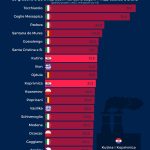As Poslovni Dnevnik writes, the director of the Directorate for Development, Investments and Competitiveness of the Tourism Economy at the Ministry of Tourism, Robert Pende, said recently on the radio that the Croatian labour force, when it comes to the all important tourism sector, currently lacks as many as 15,000 workers, although he expects the deficit to decrease as time goes on.
“Currently, according to the information we’ve received from the sector itself, there are about 10,000 people who should come or be employed for this tourist year,” said Pende, referring to the lack of workers in the tourism sector, which is ironically Croatia’s most important economic branch.
However, he pointed out that many permits for foreign workers (meaning those from non EU-EEA countries such as neighbouring Bosnia and Herzegovina and Serbia, who require special permission in order to work here) are still in the process of being requested, so he expects those numbers to be somewhat lower eventually.
MUP is notoriously slow in processing employer requests for work permits for third country nationals such as the citizens of the aforementioned non EU countries, with cases of those would-be employees throwing in the towel and going elsewhere or only being approved for their work permit when the tourist season is already well and truly underway.
“In any case, we will have a deficit, I would say, throughout the main tourist season,” Pende told HRT.
The president of the Dubrovnik County Chamber, Nikolina Trojic, said that the need at the Croatian national level is certainly between 15 and 20 thousand workers that must be introduced from somewhere.
“At the level of Dubrovnik-Neretva County alone, there are certainly at least two or three thousand people who are needed to come and work this season, so it’s that many would-be employees who are missing. It’s very difficult to fill that number from the Croatian labour force, and we will undoubtedly have to continue to import labour from abroad,” added Trojic.
Dubrovnik already has a significant number of employees each summer season from nearby Trebinje, which is just over the border in the Republika Srpska governed part of Bosnia and Herzegovina, and that alone often causes rifts among locals who remember people from Trebinje attacking Dubrovnik thirty years ago. The issue with filling the Croatian labour force isn’t only an issue economically, but on a much more personal level, with many feeling that the Dalmatian coast’s many restaurants should be filled with Croatian, preferably local staff, and not those from Bosnia and Herzegovina or Serbia.
For more, check out our business section.











